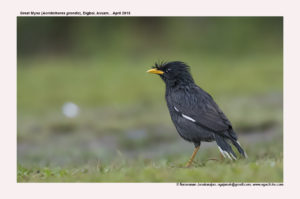
Great Myna Acridotheres grandis
Etymology :
- Acridotheres : Greek word akris- locust; theras –hunter { Locust hunter}
- Grandis : Latin word grandis – grand
Distribution in India: Resident of North East India.
Description: Size of 24·5–27·5 cm; Wt. of 95–103 g. It is a black Myna with forehead feathers elongated, forming frontal crest that may curl backwards; feathers of crown and nape are elongate and hackled. The plumage is black, with some gloss on back and wings; white bases of primaries and most of exposed primary-coverts, form a distinctive wing patch. The white tips of rectrices are broadest on outer feathers, undertail-coverts are white. The iris is reddish brown; bill is chrome-yellow; legs are yellow. Both the sexes are alike. The juvenile is duller and browner than adult, with very short frontal crest, buffish-white bases of chin and throat feathers producing spotted appearance, buffy undertail-coverts, wing patch is smaller and white tips of rectrices are narrower.
Habitat : It is found in open country, such as grasslands and marshes, including cultivated areas and rice paddies, also parks and gardens. It is found in lowlands and foothills,up to 1520 m.
Food habits: It eats insects like termites and other invertebrates. It also eats seeds, rice and berries. It forages on the ground, extracting insects from grass sward by open-bill probing; gleans insects from leaves. It uses both cattle and buffalo as beaters, catching insects disturbed by the mammals. It also removes insects and ticks from buffalo. It forages mostly in pairs; also in flocks.
Breeding habits: They breed in Apr–Aug in India. The nest is untidy structure of grass and similar material, placed in hole of high up in tree, or in crown of coconut palm , in house roof or in drainage hole in wall. They lay a clutch of 4–6 eggs.